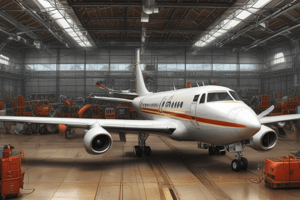Podcast
Questions and Answers
Which of the following is a primary reason for maintaining accurate records of aircraft weight and balance?
Which of the following is a primary reason for maintaining accurate records of aircraft weight and balance?
- To ensure compliance with regulatory requirements
- To optimize fuel efficiency
- To predict aircraft performance envelope
- To contribute to flight safety (correct)
What is the primary consequence of weight shifting within an aircraft during flight?
What is the primary consequence of weight shifting within an aircraft during flight?
- Alterations in the center of gravity (CG) and moments (correct)
- Fluctuations in fuel consumption
- Changes in aircraft altitude
- Variations in airspeed and heading
What is the role of pilots in managing the center of gravity (CG) during flight?
What is the role of pilots in managing the center of gravity (CG) during flight?
- To assess weight shifts and make necessary adjustments (correct)
- To monitor weather conditions and adjust accordingly
- To communicate with air traffic control about CG concerns
- To calculate weight and balance before flight
What is the term used to describe the boundaries within which an aircraft operates safely and efficiently?
What is the term used to describe the boundaries within which an aircraft operates safely and efficiently?
Why is it essential for aviation professionals to master the principles of weight and balance?
Why is it essential for aviation professionals to master the principles of weight and balance?
What is the primary impact of inaccurate weight and balance calculations?
What is the primary impact of inaccurate weight and balance calculations?
What is the term used to describe the process of redistributing weight to manage the center of gravity (CG)?
What is the term used to describe the process of redistributing weight to manage the center of gravity (CG)?
What is the primary goal of weight and balance management during flight?
What is the primary goal of weight and balance management during flight?
What is the impact of weight and balance on aircraft flight characteristics?
What is the impact of weight and balance on aircraft flight characteristics?
Why is it essential to consider weight and balance in aircraft design and operation?
Why is it essential to consider weight and balance in aircraft design and operation?
The calculation of an aircraft's center of gravity is only important during takeoff and landing.
The calculation of an aircraft's center of gravity is only important during takeoff and landing.
Weight shifting within an aircraft has a negligible impact on its flight characteristics.
Weight shifting within an aircraft has a negligible impact on its flight characteristics.
Pilots only need to consider weight and balance calculations during pre-flight preparations.
Pilots only need to consider weight and balance calculations during pre-flight preparations.
Aircraft performance envelopes are primarily determined by factors other than weight and balance.
Aircraft performance envelopes are primarily determined by factors other than weight and balance.
The movement of fuel during flight has no significant effect on an aircraft's center of gravity.
The movement of fuel during flight has no significant effect on an aircraft's center of gravity.
Aviation professionals can accurately predict an aircraft's weight and balance characteristics without considering its cargo and passenger distribution.
Aviation professionals can accurately predict an aircraft's weight and balance characteristics without considering its cargo and passenger distribution.
The principles of weight and balance are only relevant for small, single-engine aircraft.
The principles of weight and balance are only relevant for small, single-engine aircraft.
Inaccurate weight and balance calculations can lead to improved aircraft performance.
Inaccurate weight and balance calculations can lead to improved aircraft performance.
Trimming controls is an optional step in managing an aircraft's center of gravity during flight.
Trimming controls is an optional step in managing an aircraft's center of gravity during flight.
Weight and balance management is a one-time task that only needs to be performed during aircraft design.
Weight and balance management is a one-time task that only needs to be performed during aircraft design.
How does the weight of an aircraft affect its takeoff performance?
How does the weight of an aircraft affect its takeoff performance?
What is the significance of calculating an aircraft's weight and balance?
What is the significance of calculating an aircraft's weight and balance?
How does an improper loading condition affect an aircraft's stability?
How does an improper loading condition affect an aircraft's stability?
Why is it critical to maintain accurate weight and balance records?
Why is it critical to maintain accurate weight and balance records?
How does an aircraft's weight affect its climb rate?
How does an aircraft's weight affect its climb rate?
What is the role of pilots and flight crews in weight and balance control?
What is the role of pilots and flight crews in weight and balance control?
Why is it important to consider weight and balance in aircraft design and operation?
Why is it important to consider weight and balance in aircraft design and operation?
What happens when an aircraft's center of gravity (CG) is located too far forward or aft?
What happens when an aircraft's center of gravity (CG) is located too far forward or aft?
Why is it essential to consider weight and balance during all phases of flight?
Why is it essential to consider weight and balance during all phases of flight?
What is the relation between weight and balance and an aircraft's stability and control?
What is the relation between weight and balance and an aircraft's stability and control?
Flashcards are hidden until you start studying
Study Notes
Weight and Balance in Aviation
- Weight refers to the force with which gravity acts upon the aircraft, while balance concerns the location of that weight relative to the aircraft's center of gravity (CG).
- The center of gravity (CG) is the point at which the aircraft would balance if it were suspended, providing necessary stability and control during flight.
Importance of Weight and Balance
- Improperly balanced planes can lead to inefficient fuel consumption, difficulty in controlling the aircraft, and, in extreme cases, catastrophic failure.
- History provides stark lessons through incidents where weight and balance were not respected, leading to poor aircraft handling and causing stalls, spins, or even crashes.
Key Principles of Weight and Balance
- Maximum takeoff and landing weights for the specific aircraft being flown must be known.
- Aircraft weight affects various aspects of flight dynamics, including takeoff, climb rate, and maximum altitude.
- Weight determines fuel consumption, mechanical stress on the aircraft, and safety margins.
Effect of Weight on Flight Dynamics
- As weight increases, the takeoff speed must also increase to generate the necessary lift, requiring more runway space to safely lift off the ground.
- Heavier aircraft work against a greater force of gravity, requiring more thrust to maintain a desired climb rate.
- Heavier weights limit the attainable altitude, impacting fuel efficiency and flight planning over long distances or when avoiding weather.
Case Study: Gimli Glider
- An aircraft ran out of fuel mid-flight due to a miscalculation related to weight and fuel balance, illustrating the absolute necessity of precise weight management.
Recap and Conclusion
- Understanding weight dynamics is crucial for aircraft performance and safety.
- Pilots and flight planners must learn to adjust for weight variations to ensure efficient use of fuel, more padded safety margins, and overall better flight experiences.
- Weight and balance are fundamental for pilots and aviation professionals to ensure that an aircraft operates within its safe operating limits.
Weight and Balance in Aviation
- Weight refers to the force with which gravity acts upon the aircraft.
- Balance concerns the location of that weight relative to the aircraft's center of gravity (CG).
- The CG is the point at which the aircraft would balance if placed on a fulcrum, providing necessary stability and control during flight.
Importance of Weight and Balance
- Improperly balanced planes can lead to inefficient fuel consumption, difficulty in controlling the aircraft, and even catastrophic failure.
- Weight and balance affect every phase of flight, from takeoff to landing.
- Ignoring weight and balance limits can lead to poor aircraft handling, stalls, spins, or crashes.
Key Principles of Weight and Balance
- Know the maximum takeoff and landing weights for the specific aircraft being flown.
- Calculate the CG and determine whether it falls within the allowable envelope for safe flight.
- Consider the weight of cargo, fuel, passengers, and even in-flight magazines when calculating the CG.
Impact of Weight on Flight Dynamics
- Weight determines fuel consumption, mechanical stress on the aircraft, and safety margins.
- Heavier flights require more runway space to take off safely.
- A heavier aircraft works against a greater force of gravity, requiring more thrust to maintain a desired climb rate.
- Maximum altitude is limited by the weight of an aircraft, impacting fuel efficiency and flight planning.
Critical Nature of Weight Management
- Understanding the weight's influence on flight dynamics is crucial for aircraft performance and safety.
- Pilots and flight planners must adjust for weight variations to ensure efficient use of fuel, safety margins, and better flight experiences.
- Miscalculations related to weight and fuel balance can lead to serious consequences, such as the Gimli Glider incident.
Mastering Weight and Balance Control
- Computational methods, effects of loading on stability, and operational implications all contribute to mastering weight and balance control for flight safety.
- A proficient pilot recognizes the subtle yet significant influence of weight on every aspect of the flying experience.
Weight and Balance in Aviation
- Weight refers to the force of gravity acting on an aircraft, while balance concerns the location of that weight relative to the aircraft's center of gravity (CG).
- The CG is the point at which the aircraft would balance if it were suspended, and is vital for providing stability and control during flight.
Importance of Weight and Balance
- Improper weight and balance can lead to inefficient fuel consumption, difficulty controlling the aircraft, and even catastrophic failure.
- Historical incidents have shown the dire consequences of ignoring weight and balance limits, including poor aircraft handling, stalls, spins, and crashes.
Key Principles of Weight and Balance
- Maximum takeoff and landing weights must be known for the specific aircraft being flown.
- The CG must be calculated and determined to be within the allowable envelope for safe flight.
- Weight distribution, including cargo, fuel, passengers, and even in-flight magazines, must be considered.
Impact of Weight on Flight Dynamics
- Weight affects takeoff dynamics, with heavier weights requiring more runway space to take off safely.
- Weight influences climb rate, with heavier aircraft working against a greater force of gravity and requiring more thrust to maintain a desired climb rate.
- Weight impacts maximum altitude, with heavier weights limiting the attainable altitude and affecting fuel efficiency and flight planning.
Case Studies and Examples
- The crash of Air Midwest Flight 5481 was linked to weight and balance issues.
- The Gimli Glider incident, where an aircraft ran out of fuel mid-flight due to a miscalculation related to weight and fuel balance, highlights the importance of precise weight management.
Record-Keeping and Regulatory Requirements
- Accurate weight and balance records are essential for maintaining stability and control during all phases of flight.
- Pilots and flight crews must use computational methods to determine if the aircraft's weight and balance are within specified limits set forth by the Aircraft Flight Manual (AFM).
Studying That Suits You
Use AI to generate personalized quizzes and flashcards to suit your learning preferences.




